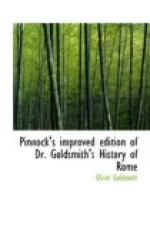[Sidenote: U.C. 991. A.D. 238.]
17. The tyrant being dead, and his body thrown to dogs and birds of prey, Pupie’nus and Balbie’nus, who had usurped the imperial purple, continued for some time emperors, without opposition. 18. But, differing between themselves, the praetorian soldiers, who were the enemies of both, set upon them in their palace, at a time when their guards were amused with seeing the Capit’oline games; and dragging them from the palace towards the camp, slew them both, leaving their dead bodies in the street, as a dreadful instance of unsuccessful ambition.
[Sidenote: U.C. 991. A.D. 238.]
19. In the midst of this sedition, as the mutineers were proceeding along, they by accident met Gor’dian, the grandson of him who was slain in Africa: him they declared emperor on the spot. 20. This prince was but sixteen years old when he began to reign, but his virtues seemed to compensate for his want of experience. His principal aims were to unite the opposing members of government, and to reconcile the soldiers and citizens to each other. 21. The army, however, began as usual to murmur; and their complaints were artfully fomented by Philip, an Arabian, who was praetorian prefect, and aspired to the sovereignty. Things thus proceeded from bad to worse. 22. Philip was at first made equal to Gor’dian in the command of the empire; shortly after he was invested with the sole power; and at length, finding himself capable of perpetrating his long meditated cruelty, Gor’dian was by his order slain, in the twenty-second year of his age, after a successful reign of nearly six years.
Questions for Examination.
1. Who succeeded Heliogabalus?
2. What was his character?
3. Was his reign peaceable?
4. How did Alexander act on the occasion?
5. Who succeeded Alexander?
6. Who was Maximin?
7. Describe his person.
8. What farther distinguished him?
9. Was his mind proportioned to his body?
10. How did he attract the notice of Severus?
11. By what means did he attain rank in the army?
12. Was he equally a terror to his foreign enemies?
13. By what means did he gain the confidence of his soldiers?
14. What effect had his cruelties on the minds of his subjects?
15. How did they accomplish their purpose?
16. How long did he reign, and what inference may be drawn from his conduct?
17. Who next mounted the imperial throne?
18. What was their end?
19. Who succeeded Pupienus and Balbienus?
20. What were the character and views of this prince?
21. Was his administration approved of by all?
22. Did Philip accomplish his ambitious design?




